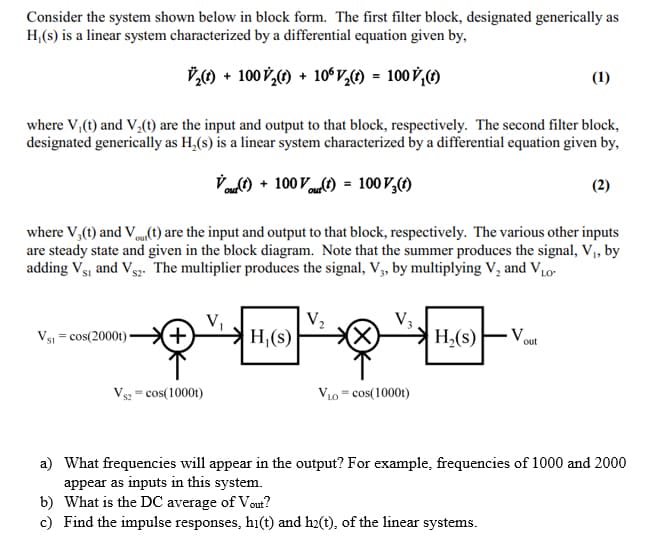What frequencies will appear in the output? For example, frequencies of 1000 and 2000 appear as inputs in this system. What is the DC average of Vout? Find the impulse responses, hi(t) and h2(t), of the linear systems.
What frequencies will appear in the output? For example, frequencies of 1000 and 2000 appear as inputs in this system. What is the DC average of Vout? Find the impulse responses, hi(t) and h2(t), of the linear systems.
Introductory Circuit Analysis (13th Edition)
13th Edition
ISBN:9780133923605
Author:Robert L. Boylestad
Publisher:Robert L. Boylestad
Chapter1: Introduction
Section: Chapter Questions
Problem 1P: Visit your local library (at school or home) and describe the extent to which it provides literature...
Related questions
Question

Transcribed Image Text:Consider the system shown below in block form. The first filter block, designated generically as
H,(s) is a linear system characterized by a differential equation given by,
V) + 100 V,) + 10ʻV,1) = 100 V,C)
(1)
where V,(t) and V,(1) are the input and output to that block, respectively. The second filter block,
designated generically as H,(s) is a linear system characterized by a differential equation given by,
Vot) + 100 Vt) = 100 V,()
(2)
where V,(t) and V(t) are the input and output to that block, respectively. The various other inputs
are steady state and given in the block diagram. Note that the summer produces the signal, V,, by
adding Vsj and Vs2. The multiplier produces the signal, V, by multiplying V, and VL0-
V5 = cos(2000t) -
+)
H,(s)
H,(s)
- V.
out
Vs2 = cos(10001)
V10 = cos(1000t)
a) What frequencies will appear in the output? For example, frequencies of 1000 and 2000
appear as inputs in this system.
b) What is the DC average of Vout?
c) Find the impulse responses, hi(t) and h2(t), of the linear systems.
Expert Solution
This question has been solved!
Explore an expertly crafted, step-by-step solution for a thorough understanding of key concepts.
Step by step
Solved in 4 steps

Knowledge Booster
Learn more about
Need a deep-dive on the concept behind this application? Look no further. Learn more about this topic, electrical-engineering and related others by exploring similar questions and additional content below.Recommended textbooks for you

Introductory Circuit Analysis (13th Edition)
Electrical Engineering
ISBN:
9780133923605
Author:
Robert L. Boylestad
Publisher:
PEARSON

Delmar's Standard Textbook Of Electricity
Electrical Engineering
ISBN:
9781337900348
Author:
Stephen L. Herman
Publisher:
Cengage Learning

Programmable Logic Controllers
Electrical Engineering
ISBN:
9780073373843
Author:
Frank D. Petruzella
Publisher:
McGraw-Hill Education

Introductory Circuit Analysis (13th Edition)
Electrical Engineering
ISBN:
9780133923605
Author:
Robert L. Boylestad
Publisher:
PEARSON

Delmar's Standard Textbook Of Electricity
Electrical Engineering
ISBN:
9781337900348
Author:
Stephen L. Herman
Publisher:
Cengage Learning

Programmable Logic Controllers
Electrical Engineering
ISBN:
9780073373843
Author:
Frank D. Petruzella
Publisher:
McGraw-Hill Education

Fundamentals of Electric Circuits
Electrical Engineering
ISBN:
9780078028229
Author:
Charles K Alexander, Matthew Sadiku
Publisher:
McGraw-Hill Education

Electric Circuits. (11th Edition)
Electrical Engineering
ISBN:
9780134746968
Author:
James W. Nilsson, Susan Riedel
Publisher:
PEARSON

Engineering Electromagnetics
Electrical Engineering
ISBN:
9780078028151
Author:
Hayt, William H. (william Hart), Jr, BUCK, John A.
Publisher:
Mcgraw-hill Education,